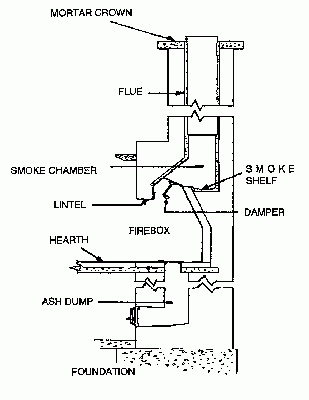Hiring a skilled and experienced chimney sweep to handle your chimney maintenance is one of the best ways to keep your family and home safe from fire. Chimney sweeps are trained to detect and remove creosote from your chimney. This dangerous build up of emissions sticks to the chimney walls and is the leading cause of chimney fires. It must be removed at least once a year.
Here is a quick view of the anatomy of a fireplace and why it should be inspected and cleaned yearly. Included are some of the commonly used terms when dealing with Chimney Sweeps.


Flue - A pipe, tube, or channel for conveying hot air, gas, steam, or smoke, as from a furnace or fireplace to a chimney.
Damper - A valve or plate (as in the flue of a furnace) for regulating the draft.
Flashing - Prevents rain water and other sources from entering your chimney.
Chimney Cap - This prevents animals and debris from entering into your chimney.
__________________________________________________________________________________________________________________
The throat is the top of the firebox below and at the damper.
The smoke shelf is the area behind the damper that is nearly level. It is the bottom of the chimney.
The smoke chamber is the sloping section of the fireplace above the damper and throat, but below the chimney flue. Typically, the sides and front of the smoke chamber slope. The back of the smoke chamber is usually vertical. This varies.
In some areas, the smoke chamber is referred to as the throat, and there is no particular name for the top of the firebox and the area of the damper. This terminology is somewhat loose and is not critical. The throat, smoke shelf and smoke chamber are typically masonry, although the smoke chamber is not usually firebrick.
Factory-built fireplaces do not usually have a smoke shelf or smoke chamber above the damper. Since most of these fireplaces draw quite nicely, the need for a smoke shelf is questionable. It is, however, a standard part of most masonry fireplaces.
The walls of the smoke chamber may have a minimum required thickness of 51/2 or 6 inches. Some jurisdictions do not allow any hollow units. In some cases, the wall thickness has to be 8 inches. A maximum slope for the sides and front is 45 off vertical. Many say that 30 is a much better arrangement. Good design typically involves the smoke chamber front and both side walls having equal slopes. When the flue is offset to one side of the fireplace or the other, the smoke chamber wall slope has to be asymmetric. This contributes to poor draft, especially if one side of the smoke chamber is vertical and the other has a dramatic slope.
The walls of the smoke chamber should be as smooth as possible. Corbelled brick is not smooth and may contribute to draft problems. When the back wall of the chamber has to be sloped, again, draft problems may be in the wings. Most designers avoid sloping the back wall of the smoke chamber, although this is common on basement fireplaces, especially those added to an existing home.
The smoke shelf is sometimes flat or almost flat. In other cases it is concave at the bottom, shaped like a cup. Most have a slight slope toward the damper. Part of the thinking is that downdrafts can be stopped and redirected so that they will actually become updrafts and help to improve the overall draft. The absence of a smoke shelf in zero clearance fireplaces may suggest that this theory is flawed.
Having your chimney cleaned and inspected once a year is a must. This will prevent carbon monoxide intrusion and will prevent fire from engulfing your chimney and maybe even your home. An extensive amount of creosote buildup in your chimney can be life threatening to you and your family. Always be sure to have your chimney inspected at least once a year.

